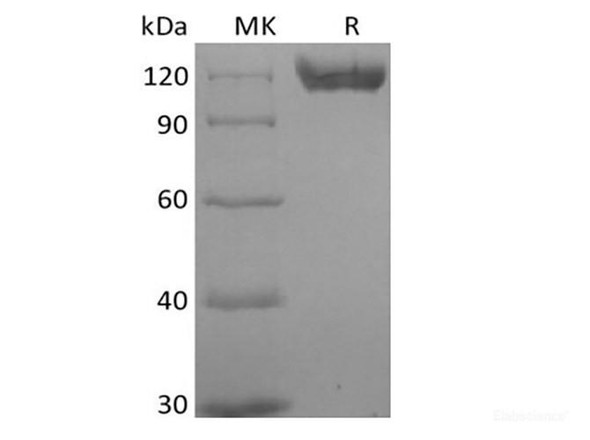Description
| Product Name: | Recombinant Human Siglec-7/CD328 (C-6His) |
| Product Code: | RPES6202 |
| Size: | 10µg |
| Species: | Human |
| Expression Host: | HEK293 Cells |
| Synonyms: | Sialic acid-binding Ig-like lectin 9, Siglec-9, CDw329, Protein FOAP-9, SIGLEC9 |
| Mol Mass: | 37.8 kDa |
| AP Mol Mass: | 50-70 kDa |
| Tag: | C-6His |
| Purity: | > 95 % as determined by reducing SDS-PAGE. |
| Endotoxin Level: | < 1.0 EU per μg of the protein as determined by the LAL method. |
| Bio Activity: | Testing in progress |
| Sequence: | Gln19-Leu353 |
| Accession: | Q9Y286 |
| Storage: | Generally, lyophilized proteins are stable for up to 12 months when stored at -20 to -80°C. Reconstituted protein solution can be stored at 4-8°C for 2-7 days. Aliquots of reconstituted samples are stable at < -20°C for 3 months. |
| Shipping: | This product is provided as lyophilized powder which is shipped with ice packs. |
| Formulation: | Lyophilized from a 0.2 μm filtered solution of PBS, pH 7.4. Normally 5 % - 8 % trehalose, mannitol and 0.01% Tween80 are added as protectants before lyophilization. Please refer to the specific buffer information in the printed manual. |
| Reconstitution: | Please refer to the printed manual for detailed information. |
| Background: | Siglecs (sialic acid binding Ig-like lectins) are I-type (Ig-type) lectins belonging to the Ig superfamily. They are characterized by an N-terminal Ig-like V-type domain which mediates sialic acid binding, followed by varying numbers of Ig-like C2-type domains. Eleven human Siglecs have been cloned and characterized. Human Siglec-7 encodes a 467 amino acid (aa) polypeptide with a hydrophobic signal peptide, an N-terminal Ig-like V-type domain, two Ig-like C2-type domains, a transmembrane region and a cytoplasmic tail. Siglec-7 exists as a monomer on the cell surface and is expressed on natural killer cells, CD8+ T cells and monocytes. It binds equally well to both alpha 2,3- and alpha 2,6-linked sialic acid. The gene encoding Siglec-7 was mapped to chromosome 19q13.3. |






